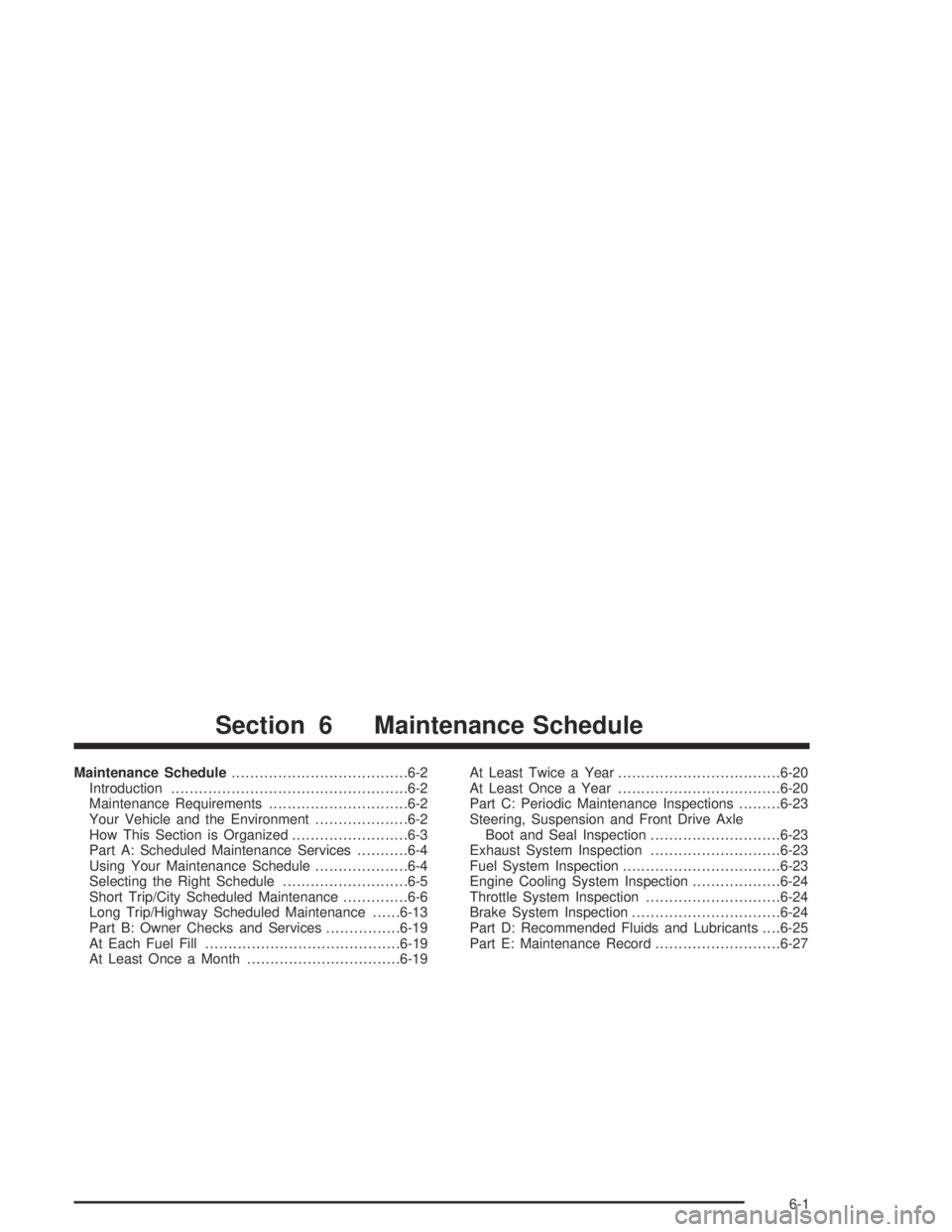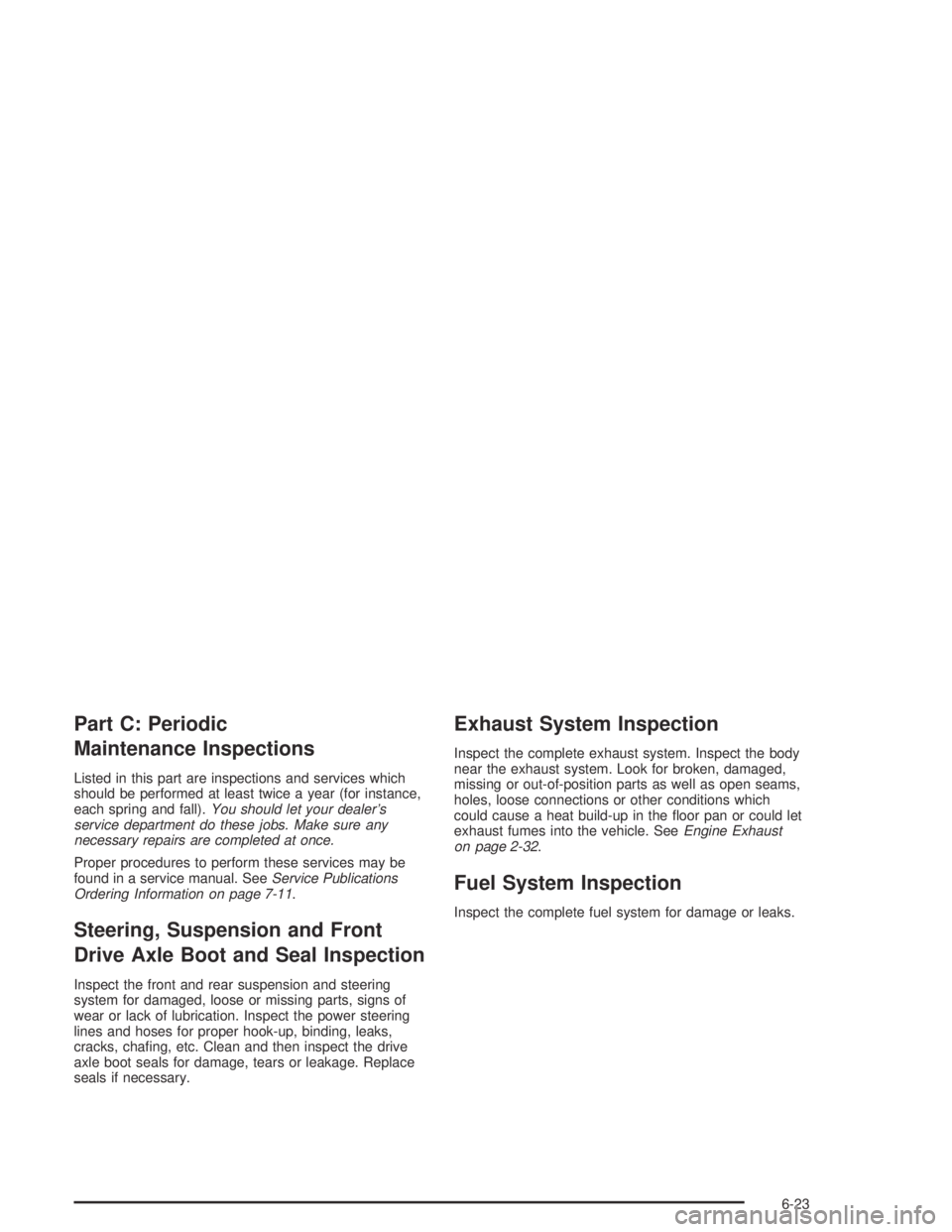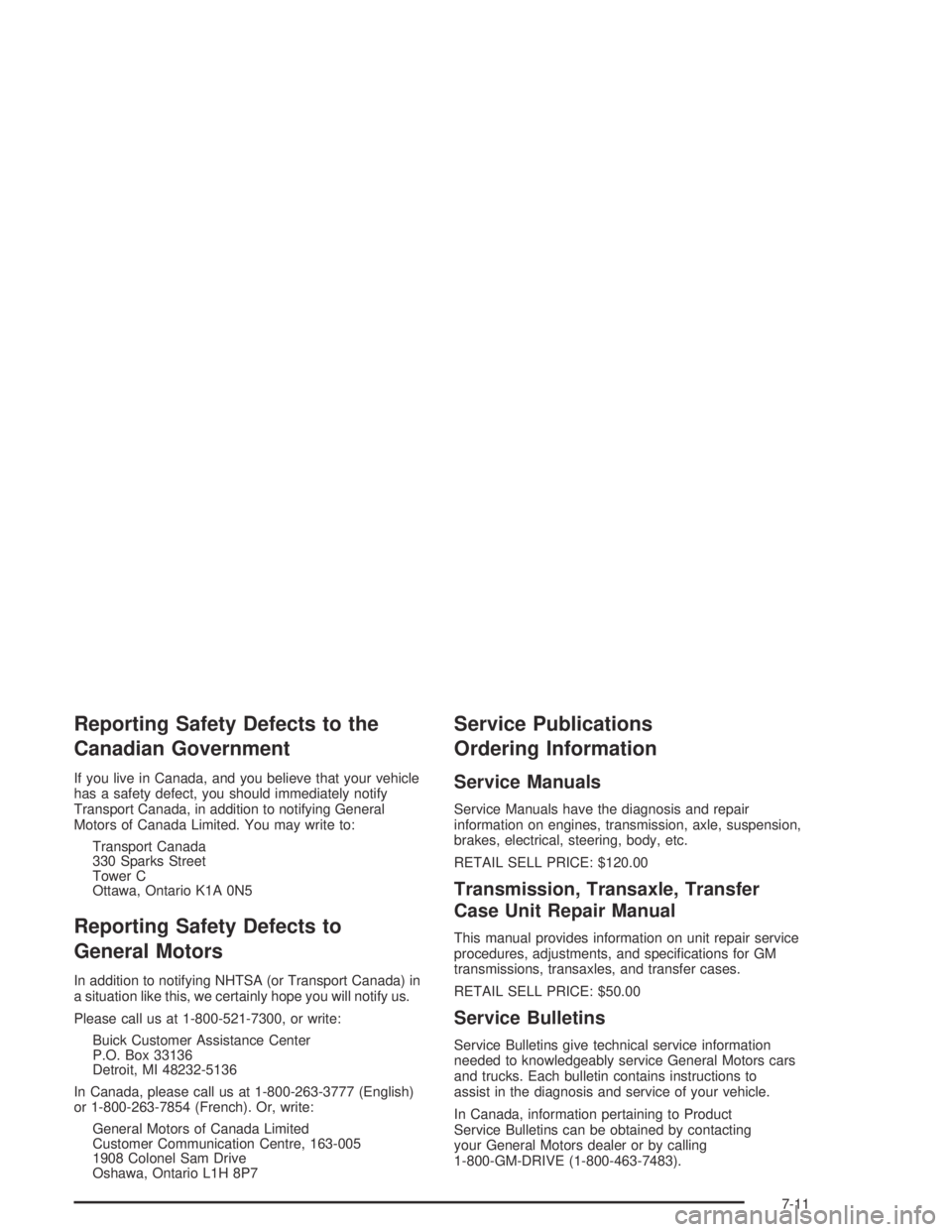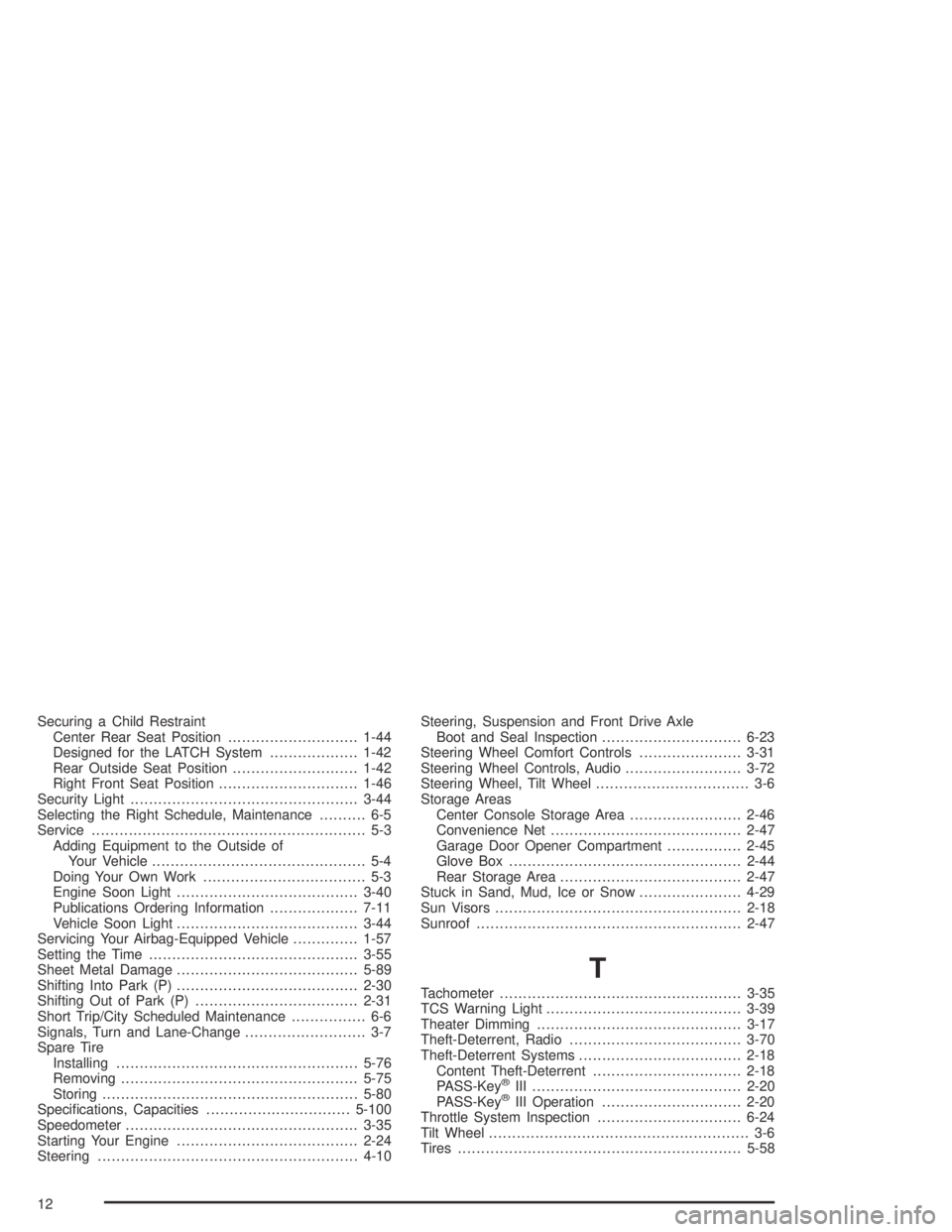2005 BUICK PARK AVENUE suspension
[x] Cancel search: suspensionPage 278 of 388

To check the aim, the vehicle should be properly
prepared as follows:
The vehicle must have all four tires on a perfectly
level surface.
If necessary, pads may be used on an
uneven surface.
The vehicle should not have any snow, ice or mud
attached to it.
The vehicle should be fully assembled and all other
work stopped while headlamp aiming is being done.
There should not be any cargo or loading of the
vehicle, except it should have a full tank of fuel and
one person or 160 lbs (75 kg) on the driver’s seat.
Close all doors.
Tires should be properly in�ated.
Rock the vehicle to stabilize the suspension.
Start with the horizontal aim. The adjustment
screws can be turned with an E8 Torx
®socket or
T15 Torx®screwdriver.
Once the horizontal aim is adjusted, then adjust the
vertical aim.1. Turn the horizontal
aiming screw (A) until
the indicator (B) is
lined up with zero.
2. Turn the vertical aiming screw (C) until the level
bubble (D) is lined up with zero.
5-46
Page 304 of 388

Used Replacement Wheels
{CAUTION:
Putting a used wheel on your vehicle is
dangerous. You can’t know how it’s been used
or how far it’s been driven. It could fail suddenly
and cause a crash. If you have to replace a
wheel, use a new GM original equipment wheel.
Tire Chains
{CAUTION:
If your vehicle has P235/55R17 size tires, do not
use tire chains, there is not enough clearance.
Tire chains used on a vehicle without the proper
amount of clearance can cause damage to the
brakes, suspension or other vehicle parts. The
area damaged by the tire chains could cause
you to lose control of your vehicle and you or
others may be injured in a crash.
Use another type of traction device only if its
manufacturer recommends it for use on your
vehicle and tire size combination and road
conditions. Follow that manufacturer’s
instructions. To help avoid damage to your
vehicle, drive slowly, readjust or remove the
device if it’s contacting your vehicle, and do not
spin your wheels.
If you do �nd traction devices that will �t, install
them on the front tires.
5-72
Page 335 of 388

Maintenance Schedule......................................6-2
Introduction...................................................6-2
Maintenance Requirements..............................6-2
Your Vehicle and the Environment....................6-2
How This Section is Organized.........................6-3
Part A: Scheduled Maintenance Services...........6-4
Using Your Maintenance Schedule....................6-4
Selecting the Right Schedule...........................6-5
Short Trip/City Scheduled Maintenance..............6-6
Long Trip/Highway Scheduled Maintenance......6-13
Part B: Owner Checks and Services................6-19
At Each Fuel Fill..........................................6-19
At Least Once a Month.................................6-19At Least Twice a Year...................................6-20
At Least Once a Year...................................6-20
Part C: Periodic Maintenance Inspections.........6-23
Steering, Suspension and Front Drive Axle
Boot and Seal Inspection............................6-23
Exhaust System Inspection............................6-23
Fuel System Inspection..................................6-23
Engine Cooling System Inspection...................6-24
Throttle System Inspection.............................6-24
Brake System Inspection................................6-24
Part D: Recommended Fluids and Lubricants. . . .6-25
Part E: Maintenance Record...........................6-27
Section 6 Maintenance Schedule
6-1
Page 357 of 388

Part C: Periodic
Maintenance Inspections
Listed in this part are inspections and services which
should be performed at least twice a year (for instance,
each spring and fall).You should let your dealer’s
service department do these jobs. Make sure any
necessary repairs are completed at once.
Proper procedures to perform these services may be
found in a service manual. SeeService Publications
Ordering Information on page 7-11.
Steering, Suspension and Front
Drive Axle Boot and Seal Inspection
Inspect the front and rear suspension and steering
system for damaged, loose or missing parts, signs of
wear or lack of lubrication. Inspect the power steering
lines and hoses for proper hook-up, binding, leaks,
cracks, cha�ng, etc. Clean and then inspect the drive
axle boot seals for damage, tears or leakage. Replace
seals if necessary.
Exhaust System Inspection
Inspect the complete exhaust system. Inspect the body
near the exhaust system. Look for broken, damaged,
missing or out-of-position parts as well as open seams,
holes, loose connections or other conditions which
could cause a heat build-up in the �oor pan or could let
exhaust fumes into the vehicle. SeeEngine Exhaust
on page 2-32.
Fuel System Inspection
Inspect the complete fuel system for damage or leaks.
6-23
Page 373 of 388

Reporting Safety Defects to the
Canadian Government
If you live in Canada, and you believe that your vehicle
has a safety defect, you should immediately notify
Transport Canada, in addition to notifying General
Motors of Canada Limited. You may write to:
Transport Canada
330 Sparks Street
Tower C
Ottawa, Ontario K1A 0N5
Reporting Safety Defects to
General Motors
In addition to notifying NHTSA (or Transport Canada) in
a situation like this, we certainly hope you will notify us.
Please call us at 1-800-521-7300, or write:
Buick Customer Assistance Center
P.O. Box 33136
Detroit, MI 48232-5136
In Canada, please call us at 1-800-263-3777 (English)
or 1-800-263-7854 (French). Or, write:
General Motors of Canada Limited
Customer Communication Centre, 163-005
1908 Colonel Sam Drive
Oshawa, Ontario L1H 8P7
Service Publications
Ordering Information
Service Manuals
Service Manuals have the diagnosis and repair
information on engines, transmission, axle, suspension,
brakes, electrical, steering, body, etc.
RETAIL SELL PRICE: $120.00
Transmission, Transaxle, Transfer
Case Unit Repair Manual
This manual provides information on unit repair service
procedures, adjustments, and speci�cations for GM
transmissions, transaxles, and transfer cases.
RETAIL SELL PRICE: $50.00
Service Bulletins
Service Bulletins give technical service information
needed to knowledgeably service General Motors cars
and trucks. Each bulletin contains instructions to
assist in the diagnosis and service of your vehicle.
In Canada, information pertaining to Product
Service Bulletins can be obtained by contacting
your General Motors dealer or by calling
1-800-GM-DRIVE (1-800-463-7483).
7-11
Page 381 of 388

I
If You Are Stuck in Sand, Mud, Ice or Snow.......4-29
Ignition Positions.............................................2-22
Infants and Young Children, Restraints...............1-29
In�ation -- Tire Pressure..................................5-64
Inspection
Brake System.............................................6-24
Engine Cooling System................................6-24
Exhaust System..........................................6-23
Fuel System...............................................6-23
Part C - Periodic Maintenance.......................6-23
Steering, Suspension and Front Drive Axle
Boot and Seal.........................................6-23
Throttle System...........................................6-24
Instrument Panel
Brightness..................................................3-16
Cluster.......................................................3-33
Overview..................................................... 3-4
J
Jump Starting.................................................5-41
K
Keyless Entry System....................................... 2-5
Keys............................................................... 2-3
L
Labelling, Tire Sidewall....................................5-59
Lamps
Battery Run-Down Protection.........................3-19
Cornering...................................................3-15
Courtesy....................................................3-16
Exterior......................................................3-14
Front Reading.............................................3-18
Glove Box..................................................3-18
Rear Reading.............................................3-19
Trunk.........................................................3-19
Twilight Sentinel
®........................................3-16
LATCH System
Child Restraints...........................................1-40
Securing a Child Restraint Designed
for the LATCH System..............................1-42
Leaving Your Vehicle.......................................2-13
Light
Airbag Readiness........................................3-36
Anti-Lock Brake System Warning...................3-39
Battery Warning..........................................3-37
Brake System Warning.................................3-38
Cruise Control.............................................3-44
Malfunction Indicator....................................3-40
Oil Pressure...............................................3-43
Safety Belt Reminder...................................3-36
Security.....................................................3-44
7
Page 382 of 388

Light (cont.)
Service Vehicle Soon...................................3-44
TCS Warning Light......................................3-39
Traction Control System (TCS) Warning..........3-39
Lighting
Delayed Entry.............................................3-17
Delayed Exit...............................................3-17
Entry.........................................................3-16
Parade Dimming..........................................3-18
Perimeter...................................................3-17
Theater Dimming.........................................3-17
Lockout Protection..........................................2-13
Locks
Central Door Unlocking System.....................2-10
Delayed Locking..........................................2-11
Door........................................................... 2-9
Leaving Your Vehicle....................................2-13
Lockout Protection.......................................2-13
Power Door................................................2-10
Programmable Automatic Door Locks.............2-11
Rear Door Security Locks.............................2-13
Long Trip/Highway Scheduled Maintenance........6-13
Loss of Control...............................................4-14
Lumbar
Power Controls............................................. 1-3M
Maintenance, Normal Replacement Parts..........5-101
Maintenance Schedule
At Each Fuel Fill.........................................6-19
At Least Once a Month................................6-19
At Least Once a Year..................................6-20
At Least Twice a Year..................................6-20
Brake System Inspection..............................6-24
Engine Cooling System Inspection.................6-24
Exhaust System Inspection...........................6-23
Fuel System Inspection................................6-23
How This Section is Organized....................... 6-3
Introduction.................................................. 6-2
Long Trip/Highway Scheduled Maintenance.....6-13
Maintenance Requirements............................. 6-2
Part A - Scheduled Maintenance Services......... 6-4
Part B - Owner Checks and Services.............6-19
Part C - Periodic Maintenance Inspections......6-23
Part D - Recommended Fluids
and Lubricants.........................................6-25
Part E - Maintenance Record........................6-27
Selecting the Right Schedule.......................... 6-5
Short Trip/City Scheduled Maintenance............. 6-6
Steering, Suspension and Front Drive Axle
Boot and Seal Inspection..........................6-23
Throttle System Inspection............................6-24
Using Your................................................... 6-4
Your Vehicle and the Environment................... 6-2
8
Page 386 of 388

Securing a Child Restraint
Center Rear Seat Position............................1-44
Designed for the LATCH System...................1-42
Rear Outside Seat Position...........................1-42
Right Front Seat Position..............................1-46
Security Light.................................................3-44
Selecting the Right Schedule, Maintenance.......... 6-5
Service........................................................... 5-3
Adding Equipment to the Outside of
Your Vehicle.............................................. 5-4
Doing Your Own Work................................... 5-3
Engine Soon Light.......................................3-40
Publications Ordering Information...................7-11
Vehicle Soon Light.......................................3-44
Servicing Your Airbag-Equipped Vehicle..............1-57
Setting the Time.............................................3-55
Sheet Metal Damage.......................................5-89
Shifting Into Park (P).......................................2-30
Shifting Out of Park (P)...................................2-31
Short Trip/City Scheduled Maintenance................ 6-6
Signals, Turn and Lane-Change.......................... 3-7
Spare Tire
Installing....................................................5-76
Removing...................................................5-75
Storing.......................................................5-80
Speci�cations, Capacities...............................5-100
Speedometer..................................................3-35
Starting Your Engine.......................................2-24
Steering........................................................4-10Steering, Suspension and Front Drive Axle
Boot and Seal Inspection..............................6-23
Steering Wheel Comfort Controls......................3-31
Steering Wheel Controls, Audio.........................3-72
Steering Wheel, Tilt Wheel................................. 3-6
Storage Areas
Center Console Storage Area........................2-46
Convenience Net.........................................2-47
Garage Door Opener Compartment................2-45
Glove Box..................................................2-44
Rear Storage Area.......................................2-47
Stuck in Sand, Mud, Ice or Snow......................4-29
Sun Visors.....................................................2-18
Sunroof.........................................................2-47
T
Tachometer....................................................3-35
TCS Warning Light..........................................3-39
Theater Dimming............................................3-17
Theft-Deterrent, Radio.....................................3-70
Theft-Deterrent Systems...................................2-18
Content Theft-Deterrent................................2-18
PASS-Key
®III .............................................2-20
PASS-Key®III Operation..............................2-20
Throttle System Inspection...............................6-24
Tilt Wheel........................................................ 3-6
Tires.............................................................5-58
12